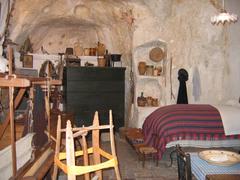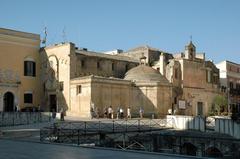San Nicola all’Ofra: Visiting Hours, Tickets, and Complete Guide to Matera’s Historic Rock Church
Date: 14/06/2025
Introduction
San Nicola all’Ofra—also known as San Pellegrino all’Ofra—is one of Matera’s most remarkable rupestrian (rock-cut) churches, offering a unique immersion into the region’s medieval monastic heritage, spiritual traditions, and distinctive rock architecture. Overlooking the dramatic Gravina di Matera canyon on the southeastern edge of the city, this multi-level complex is carved directly into limestone cliffs and represents the fusion of Byzantine and Latin Christian influences that shaped southern Italy between the 9th and 13th centuries. Its austere interiors, adorned with medieval frescoes, particularly those depicting Saint Nicholas, highlight its religious significance as a site of worship, retreat, and ascetic life.
San Nicola all’Ofra is not only an artistic and spiritual treasure but also an architectural marvel. Ingeniously designed hypogean cisterns, rock-cut chapels, and interconnected stairways adapt to the rugged terrain, illustrating the resilience and evolving relationship between local communities and their environment. As a part of the UNESCO World Heritage Site “The Sassi and the Park of the Rupestrian Churches of Matera,” San Nicola all’Ofra stands as a testament to Matera’s layered history.
This guide provides a comprehensive overview of San Nicola all’Ofra’s history, architecture, visiting hours, ticketing information, accessibility, and practical travel tips—helping you plan an enriching visit to one of Italy’s most fascinating historical sites (Matera Welcome, Parco Murgia, Along Dusty Roads, Matera Tour Guide).
Historical Overview
Origins and Early Development
San Nicola all’Ofra’s origins trace back to the medieval period, likely between the 9th and 13th centuries CE, during a time when monastic settlements flourished on the Murgia plateau. It was established by communities of hermits and monks, influenced by both Latin and Byzantine Christian traditions. The church’s name, derived from the Greek “ophra” (meaning “height” or “hill”), references its elevated position overlooking Matera’s dramatic ravine.
Architectural Features
Integrated into the cliff face, the complex unfolds across four principal levels, connected by corridors, stairways, and ledges. Architectural highlights include:
- Rock-cut chapels and living quarters: Featuring a single nave with an apsidal niche and notable 19th-century frescoes.
- Hypogean cisterns: Ingenious water management systems adapted to the arid environment.
- Functional spaces: Ancient ovens, hearths, and animal pens, reflecting the site’s later agricultural uses.
- Adaptations: Internal corridors and stairways were added over time to counter rockfalls and maintain accessibility.
Religious and Monastic Significance
During the Middle Ages, San Nicola all’Ofra served as a place of worship and communal living for monks or hermits. Its frescoes—especially those of Saint Nicholas—alongside carved liturgical furnishings and arcosolia, underscore its religious importance and use as a monastic retreat.
Later Transformations
By the 18th century, as monastic life waned, the complex was repurposed by shepherds and farmers as animal shelters and storage areas. Modifications such as dry-stone walls and feeding troughs were introduced, but the core religious spaces retained traces of their original function.
Artistic and Archaeological Remains
San Nicola all’Ofra preserves valuable frescoes (including a 13th–14th-century depiction of a bishop, likely Saint Nicholas), 19th-century religious paintings, and carved architectural details. The hypogean cisterns and other remnants speak to the resourcefulness of its medieval inhabitants.
Conservation Status
Today, San Nicola all’Ofra is part of the UNESCO World Heritage Site “The Sassi and the Park of the Rupestrian Churches of Matera.” While partially ruined and abandoned, ongoing preservation efforts are focused on stabilizing the rock, conserving frescoes, and managing visitor impact (UNESCO).
Visitor Information
Location and Access
San Nicola all’Ofra is located within the Parco della Murgia Materana, just outside Matera’s historic center. The site is best accessed on foot via hiking trails from the city center or nearby villages. The trek is of moderate difficulty, typically taking 30–40 minutes from Matera’s Sassi district, with the final approach involving uneven and sometimes steep paths (Parco Murgia, Earth Trekkers).
Directions:
- From Piazza Vittorio Veneto, head south on Via Luigi Sturzo, then left onto Via Roma. Follow signs for Via delle Cisterne to the Sassi’s edge, then continue on marked paths through the countryside.
- Signage is present but subtle. Using GPS-enabled devices or hiring a local guide is recommended.
Visiting Hours and Tickets
- Hours: The site is generally open from 9:00 AM to 6:00 PM, with longer hours in summer. There is no official ticket office, so actual hours may vary. Always check with local tourism offices or official websites before visiting (Matera Welcome, Evendo).
- Tickets: Entry is free as of mid-2024. Guided trekking or walking tours may have associated fees. Tickets can be arranged through local operators if included in broader itineraries.
Accessibility
Due to the rocky and uneven terrain, San Nicola all’Ofra is not wheelchair accessible. Visitors with limited mobility may find the approach challenging; assistance is recommended. Contact local guides in advance to discuss possible accommodations.
Guided Tours and Events
- Guided Tours: While there are no regular guided tours exclusively for San Nicola all’Ofra, some local operators include it in Matera’s Sassi and Murgia area walking tours (Matera Tour Guide).
- Special Events: Occasionally, the site is included in cultural or religious events linked to Matera’s annual festivities. Details can be found via local tourism listings.
Travel Tips
- Wear sturdy, non-slip footwear.
- Bring water, snacks, and sun protection (hat, sunscreen, sunglasses).
- Carry a flashlight or use your smartphone to illuminate the dim interior.
- There are no facilities (restrooms, shops) on-site; use amenities in Matera’s Sassi district or city center.
- Avoid visiting after heavy rain due to slippery paths.
Artistic and Architectural Highlights
Interior Frescoes and Iconography
San Nicola all’Ofra is famed for its medieval frescoes, including depictions of the Madonna and Child flanked by Saint Nicholas and other saints. The frescoes date from the 11th to 14th centuries, with later additions in the 19th century, reflecting both Byzantine and local artistic styles (Along Dusty Roads, GPSmyCity). The color palette—rich in reds, ochres, and blues—and geometric or floral motifs contribute to the sacred atmosphere.
Liturgical Features
The church’s liturgical layout includes a main altar carved from the living rock, oriented eastward, and side niches for private devotion. Remnants of arcosolia, a chancel, and possible iconostasis (influenced by Eastern Christian traditions) are visible.
Integration with the Landscape
Perched on the edge of the Gravina ravine, San Nicola all’Ofra offers breathtaking views of Matera’s canyons and ancient districts. The harmonious integration of architecture and natural environment is a hallmark of Matera’s rupestrian heritage (Go Ask a Local).
Conservation and Preservation
Ongoing conservation projects focus on stabilizing the rock structure, preventing erosion, and safeguarding the fragile frescoes from humidity and visitor impact. Restoration is conducted with respect for the original artistry and minimal intervention to preserve authenticity (Along Dusty Roads).
Nearby Attractions
- Sassi di Matera: Ancient cave dwellings and UNESCO World Heritage Site.
- Other Rupestrian Churches: Over 150 rock-hewn churches in the region, including Cripta del Peccato Originale and Santa Maria de Idris.
- Matera Cathedral: A stunning example of Apulian-Romanesque architecture.
Frequently Asked Questions (FAQ)
Q: What are the visiting hours?
A: Generally from 9:00 AM to 6:00 PM (longer in summer), but hours may vary. Check with local tourism offices for up-to-date information.
Q: Are tickets required?
A: Entry is free; guided tours may have a fee.
Q: Is the site accessible for people with disabilities?
A: Accessibility is limited due to the rugged terrain.
Q: Can I visit independently?
A: Yes, but guided tours are recommended for deeper insight and safety.
Q: Is photography allowed?
A: Photography is usually permitted, but avoid using flash and respect any posted restrictions.
Visual & Interactive Resources
- Images: Look for photos of the church entrance, interior frescoes, and panoramic views of the Gravina canyon.
- Alt text examples: “Entrance to San Nicola all’Ofra, a rock-cut church in Matera”; “19th-century fresco of Madonna and Child inside San Nicola all’Ofra.”
- Maps: Use walking route maps from Matera’s city center.
- Virtual Tours: Available through official tourism websites and select travel blogs.
Conclusion
San Nicola all’Ofra stands as a profound testament to Matera’s rupestrian heritage, blending history, art, and the natural landscape. For travelers interested in history, art, or architecture, this rock-hewn church offers an immersive experience into the spiritual and cultural evolution of southern Italy. With careful planning—considering terrain, weather, and guided options—your visit will be both safe and memorable.
For the latest information on visiting hours, tickets, and tours, consult the Matera Welcome portal, and consider downloading the Audiala app for guided audio tours and updates on Matera’s historic sites.
Summary of Key Points
- San Nicola all’Ofra is a significant medieval rupestrian church, part of Matera’s UNESCO World Heritage landscape.
- The site is open during daylight hours, free to enter, but requires preparation for the rugged terrain.
- Guided tours are available through local operators and enhance the visitor experience.
- Combine your visit with other sites in Matera for a comprehensive exploration of the region’s cultural and religious history.
- For updates and resources, use official tourism websites and mobile apps like Audiala.
References
- San Nicola all’Ofra: Exploring One of Matera’s Most Fascinating Historical Sites, Visiting Info & More, 2024
- San Nicola All’Ofra: Visiting Hours, Tickets & Guide to Matera’s Historic Cave Church, 2024
- San Nicola All’Ofra: Visiting Hours, Tickets, and History of Matera’s Rupestrian Church, 2024
- San Nicola all’Ofra Visiting Hours, Tickets & Guide to Matera’s Historic Rock Church, 2024
- UNESCO World Heritage Listing for Matera, 1993


